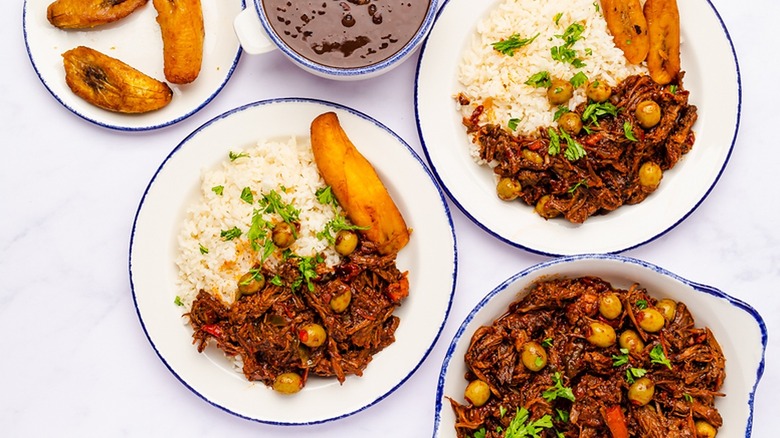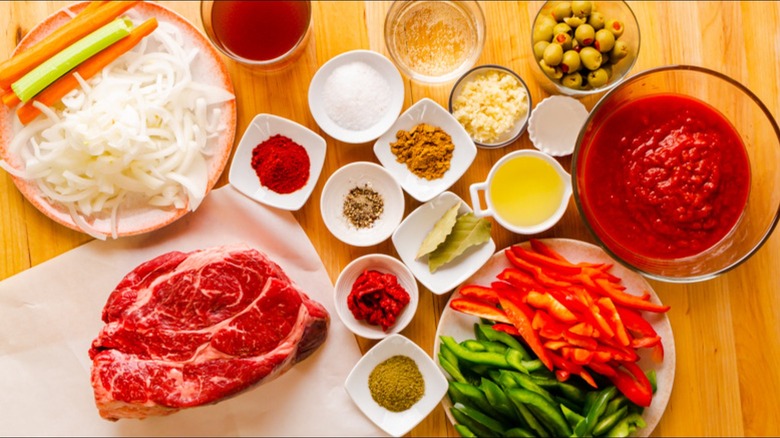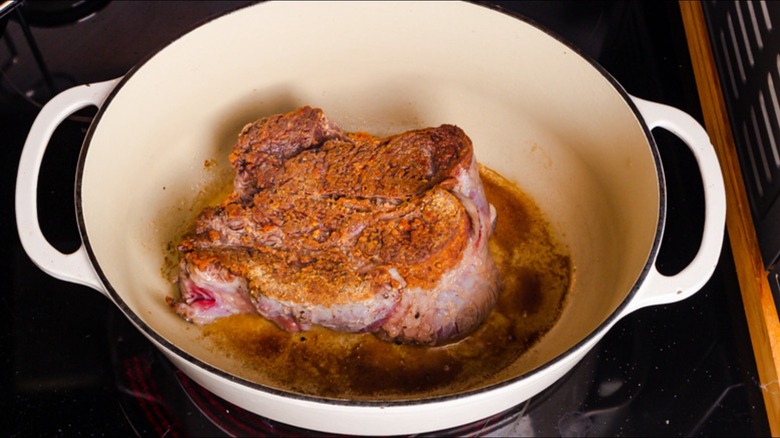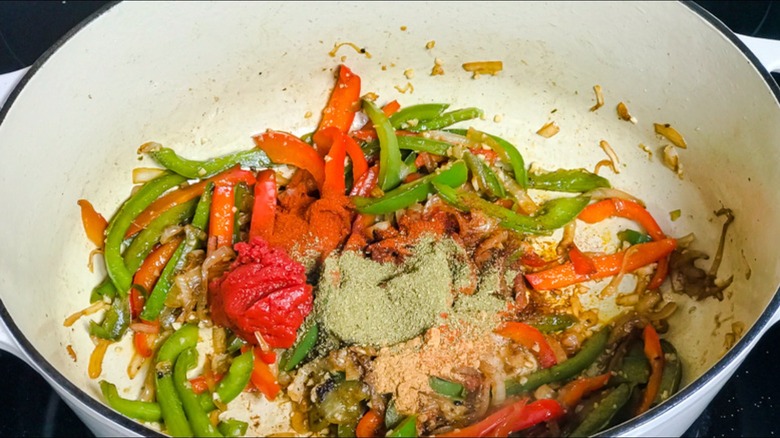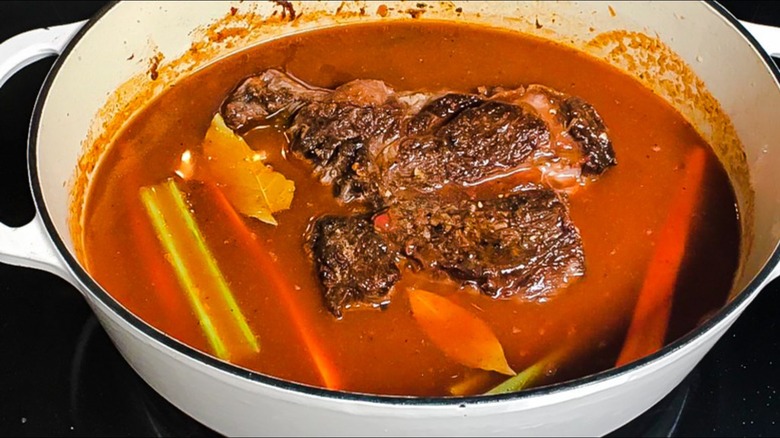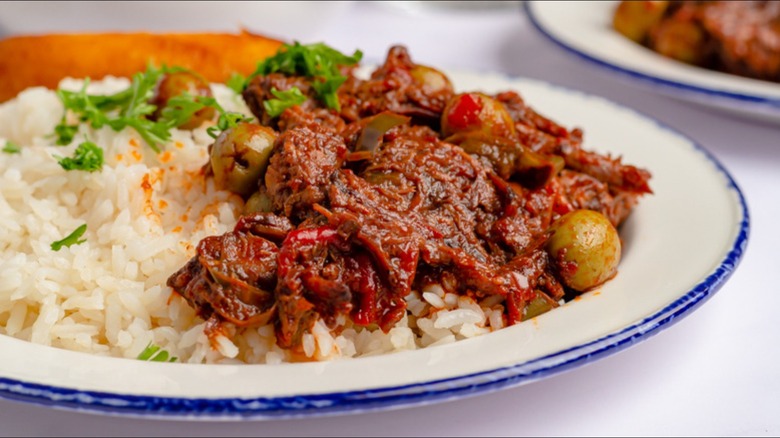Authentic Ropa Vieja Recipe
Ropa vieja is a dish with a rather unappetizing name, at least if you know the Spanish translation: "old clothes," according to Revolución de Cuba. There's actually a rather charming legend behind the name, though. According to an old story, a poor man had no food to feed his family, so he boiled up his old clothes in a cauldron. As he cooked, he prayed, and a miracle happened –- the "ropa vieja" transformed into a delicious, filling meat stew.
Okay, so it's not likely that the dish really started out as a batch of boiled rags, but it seems that it did originate with the Sephardic Jews of Spain who used to cook it on the day before the Sabbath so that they would have something to eat on the holy day when chores like cooking were forbidden. According to recipe developer Carlos Leo, in modern times ropa vieja is considered to be Cuba's national dish. "This dish [is] very well known in Miami," he tells us, adding, "you can find it in every Cuban restaurant everywhere." He describes it as beef slow-cooked with the seasoned tomato sauce known as sofrito, and says, "what identifies this dish [is] the Spanish stuffed olives with red pepper." As for the flavor, Leo tells us, "My husband said that this dish tastes similar to the Filipino adobo dish," while he describes it as "bold and rich."
Assemble the ingredients for the ropa vieja
This dish has a rather lengthy list of ingredients, although none of them are too exotic or hard to find. For the meat, Leo uses chuck roast, while the vegetables include a yellow onion, red and green bell peppers, a carrot, and celery. You'll need olive oil for cooking, and the sauce is made from crushed tomatoes, tomato paste, white wine, and beef broth, all seasoned with fresh garlic, cumin, paprika, oregano, and bay leaves. To finish things off, you'll be using pimento-stuffed green olives and a bit of vinegar, and you can garnish the dish with cilantro or parsley if you like.
Leo tells us that "The Cubans normally use adobo to season their food," but admits, "I didn't use it in this recipe because I don't like to use adobo and I prefer to cook with natural ingredients."
Start by browning the meat
Begin by seasoning the beef with 1 tablespoon plus an additional ¼ teaspoon of salt (Leo likes to use sea salt), as well as ½ teaspoon of black pepper. Heat a cast-iron skillet on high, and pour 3 tablespoons of oil into the pan. When the oil is hot, brown the meat for about 5 minutes on each side. Once the meat is seared, remove it from the pan and set it aside for the moment.
Cook the vegetables
Add the remaining tablespoon of oil to the pan and cook the onions and peppers over medium heat for 10 minutes, stirring frequently. After 10 minutes is up, add the garlic and cook, continuing to stir, for 1 more minute. Now add the cumin, paprika, and oregano along with the tomato paste, and cook for 1 more minute. Pour the wine into the pan and turn the heat up to bring everything to a boil. Use a wooden spoon to scrape the browned bits off the bottom of the pan and cook until the wine has evaporated. Once the wine is all gone, pour in the beef broth and add the crushed tomatoes, then turn the heat down to a simmer.
Simmer the stew for a few hours
Put the meat back in the pan and add the bay leaves, carrot, and celery. Leo points out that "All the ingredients should be submerged into the liquid," and advises adding more broth or water if this is necessary. Cover the pan and cook the ropa vieja for 2 ½ hours, stirring occasionally and adding additional liquid if needed to keep the sauce from getting too thick. At the end of this time, the beef should be fork-tender.
In a hurry? Leo suggests, "You could save some time and use the pressure cooker or the Instant Pot to cook the meat instead of slow cooking the beef."
Finish off the ropa vieja
When the ropa vieja is (almost) done, remove the meat and shred it using two forks. Take the bay leaves and celery out of the pan and do what you will with them, but the part they play in this dish is done. Same with the carrot, although Leo does say you can mash it and stir it into the sauce if you like to add a little sweetness and serve as a thickener. Stir the vinegar into the sauce, then add the shredded beef back into the pot. Mix the olives in, too.
You should be all done now, but if the sauce is thinner than you'd like, you can cook the ropa vieja a bit longer to thicken it up. You can garnish the stew with chopped parsley or cilantro before serving. Leo suggests ladling the ropa vieja over a base of rice, black beans, mashed potatoes, or maduros (fried plantains), and says that it goes well with beer or wine.
Authentic Ropa Vieja Recipe
This authentic ropa vieja dish is a Cuban favorite. Although it requires a few hours to slow cook the meat, we guarantee you won't regret it!
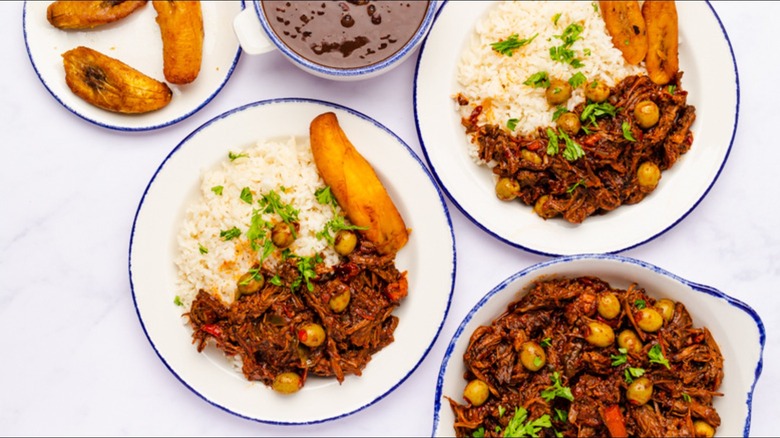
Ingredients
- 2 pounds beef chuck roast
- 1 tablespoon + ½ teaspoon of salt, divided
- ½ teaspoon ground black pepper
- 4 tablespoons olive oil, divided
- 1 large yellow/Spanish onion, thinly sliced
- 1 green bell pepper, thinly sliced
- 1 red bell pepper, thinly sliced
- 7 garlic cloves, minced
- 2 teaspoons ground cumin
- 2 teaspoons sweet paprika
- 2 teaspoons dried oregano
- 1 ½ tablespoon tomato paste
- ½ cup dry white wine
- 4 cups beef broth
- 1 (16-ounce) can crushed tomatoes
- 2 bay leaves
- 1 large carrot, cut in half
- 1 large celery stalk, cut in half
- 2 teaspoons distilled white vinegar
- 1 cup pimiento-stuffed Spanish olives, rinsed and drained
Optional Ingredients
- ⅓ cup chopped cilantro or parsley for garnish if desired
Directions
- Season the beef chuck roast with 1 tablespoon + ¼ teaspoon of salt and ½ teaspoon pepper.
- Heat a large cast-iron pan on high, and add 3 tablespoons of olive oil.
- Sear the chuck roast, turning it until it is brown on all sides (about 5 minutes per side).
- Remove the meat from the pan and set it aside.
- Cook the onion, peppers, and ¼ teaspoon of salt in 1 tablespoon of olive oil in the same pan over medium heat for about 10 minutes, stirring frequently.
- Add the garlic and cook for 1 minute.
- Stir in the cumin, paprika, oregano, and tomato paste and cook for 1 minute.
- Add the wine and increase the heat to a boil.
- Scrape the bottom of the pan with a wooden spoon to deglaze until the wine evaporates.
- Stir in the beef broth and crushed tomatoes and reduce the heat to a simmer.
- Return the browned chuck roast to the pan and add in the bay leaves, carrot, and celery, adding liquid if necessary to cover.
- Cover and cook for 2 ½ hours until the beef is fork-tender, stirring occasionally and adding more liquid if the sauce gets too thick.
- Remove the meat from the pan and shred it with two forks.
- Remove the bay leaves and celery from the pan and discard.
- Mash the carrot into the sauce to thicken, if desired.
- Stir the vinegar into the sauce.
- Return the shredded beef to the sauce.
- Add the Spanish olives into the pan and stir to combine.
- Garnish with cilantro or parsley.
Nutrition
| Calories per Serving | 306 |
| Total Fat | 15.2 g |
| Saturated Fat | 3.7 g |
| Trans Fat | 0.3 g |
| Cholesterol | 72.6 mg |
| Total Carbohydrates | 13.6 g |
| Dietary Fiber | 3.4 g |
| Total Sugars | 5.9 g |
| Sodium | 927.6 mg |
| Protein | 28.6 g |
